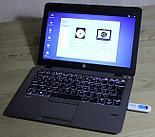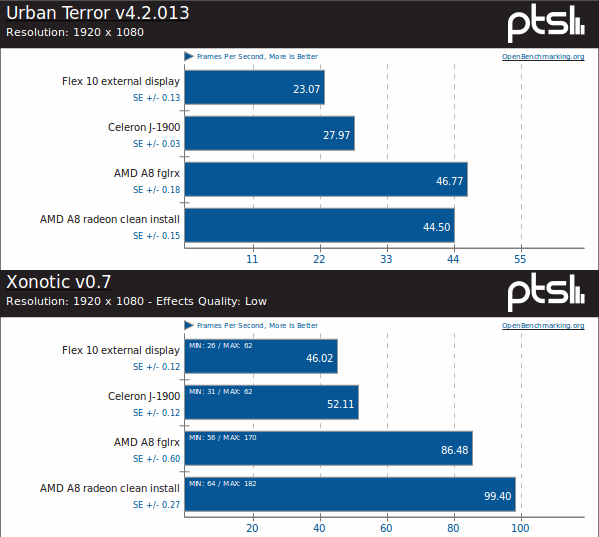Performance of AMD A8 APU on Xubuntu 15.04 with radeon and fglrx drivers
AMD can't compete with Intel in the field of raw performance in general, but it gets interesting when you look at some specific price ranges or product types. You can find AMD chips in some laptops offering decent CPU and good GPU performance. There are also affordable mini-ITX boards for AMD APUs that can compete with Intel Bay Trail boards.
How does AMD based computer (a EliteBook 725 G2 laptop in this case) performs on modern Linux distribution? What is the difference between open radeon
and close-source fglrx
graphics driver? Is the user experience as good as with Intel or Intel+nVidia based laptops?
Few words about HP EliteBook 725 G2
HP EliteBook 725 G2 is a 12,5" businesses laptop, a top shelf
priced around $900 or more depending on configuration. On resale used laptops tend to loose a lot of it value bringing them to the price point of entry level BayTrail laptops. Intel base EliteBooks seems to retain more of it original prices. The original price is high but you get better warranty service and additional security features not present on high performance gaming laptops of similar price.

The model I played with was equipped with AMD A8 PRO-7150B and 4 GB of RAM. The keyboard was backlit (where reviews mention AMD A10 and no backlit). When you remove the back plate you get access to two SODIMM RAM slots, HDD, battery, WiFi miniPCIe card and WWAN card slot (3G/LTE/HSDPA/GPS modem).


On the sides we have 3 USB3 ports, VGA and DisplayPort, Ethernet and SD card reader. The laptop also has a custom docking station connector as well as SmartCard and fingerprint readers.
11,6" is a common size for small and portable convertible or entry-level laptops. This one is slightly bigger which allows it to have slightly bigger keyboard - making it more comfortable to use. Partially metal case and no flex adds to that experience.

Linux on HP EliteBook 725 G2
For the tests I've picked pre-final Xubuntu 15.04. After switching secure-boot (and going from UEFI to legacy mode for easy of use) I've installed the system on a custom SSD driver. The system booted and worked except of the Broadcom BCM43228 WiFi card. In system settings - Additional Drivers
there was a driver option for it. After installing the driver the card started to work, but WiFi still couldn't find any access points. After some searching it turned out that it needs intremap=off added to boot options (can be added to /etc/default/grub). After that the WiFi was fully operational.
I didn't tested the SmartCard identity card reader as well as the fingerprint scanner.
AMD GPU on Linux
On Linux we can pick either open source radeon
or closed fglrx
drivers. Soon there will be a big change to those drivers as AMD wants to have one kernel module for both and fglrx limited to a binary blob in the user space.
By default (X)Ubuntu will use radeon driver which surprisingly works very well, especially when compared to nouevau for nVidia which installed by default on my Intel + Optimus nVidia laptop making desktop perform very badly.
Fglrx driver can be picked from the additional drivers settings and after a reboot you will be on fglrx. If you want to switch back to radeon be sure to check what driver will be used in the end as in my case after switching the driver in the additional drivers settings and rebooting I got llvmpipe which is a CPU-based GPU driver for debugging and so on (with near-to-zero performance).
Performance and benchmarks
The opensource driver performs remarkably well and I don't even see a need to switching to the closed-source one (where it's needed for nVidia GPUs). It's quite surprising and a positive thing.
It's hard to tell which of the two drivers is better. Among various benchmarks they switched places and there was no clear winner. Here is a set of phoronix benchmarks I ran on that laptop:
- Intel Bay Trail comparison
- Games part I
- Games part II
- GPU benchmark
- Comparison with desktop i7-2600K
- Comparison with AMD FX 8320
Just install phoronix-test-suite
and you will be able to run those tests on your system and compare results.

RAM operations were much quick on radeon for some reason
RAM speed gave surprising results. With radeon driver the speed was much faster. Some games also gave more FPS with that driver.

Radeon and fglrx achieve similar performance but radeon wins more often
In the C-Ray benchmark measuring floating point performance the AMD A8 got similar score as Celeron J1900. The same was true for VP8/WebM encoding. That's not a good result as J1900 is less power demanding and it's designed for entry-level devices. In other benchmarks AMD A8 was noticeably better than Celeron. I've also made two comparisons with other phoronix test results - for i7-2600K and AMD FX 8320 - you won't get desktop performance from that laptop CPU, but still interesting to check. In CAD benchmark (SPECViewPerf) the fglrx driver was noticeably better and was able to actually run more tests than the open source one.

In CPU tests the AMD A8 is better than Bay Trail J1900
Summary
As you can see the open source radeon driver works nicely and you don't have to use the closed-source one. The AMD A8 PRO-7150B has a decent performance. It's not worth the top-shelf
price but when the price goes down on resale it may be worth it, as it's in general better than entry level Intel CPUs (but who knows what Braswell and SkyLake will bring, or also AMD Carrizo).
HP EliteBook 725 G2 looks like a quite handy and well made laptop. The official price is a killer but maybe business/corporation users require additional security and management features (like TPM for encryption) or quicker warranty repairs and services. Among competitors we have Bay Trail cheap laptops, often convertible or with rotating 11.6-13.3" screens. Top-shelf is filled with Core-M class ultra thing devices. Such devices are usually fanless or come with small fan and can work on batteries longer due to lower TDP. On the other hand their GPU (and CPU) is tuned for low-heat and low-power consumption, and for example limited to 8 GB of RAM for Bay Trail (and successor Braswell). AMD isn't best in that but just keeps it simple and retains more features.
Comment article